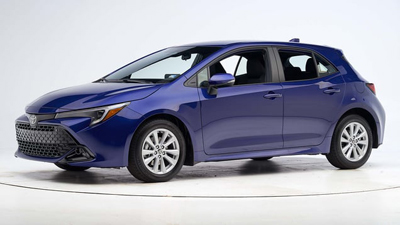The Insurance Institute for Highway Safety (IIHS) is strengthening the requirements for its TOP SAFETY PICK and TOP SAFETY PICK+ awards in 2023, demanding better side crash protection and improved pedestrian crash prevention systems and eliminating subpar headlights from the field of qualifying vehicles.
As a result of the tougher criteria, only 48 models qualify for 2023 awards. Of those, 28 earn TOP SAFETY PICK+ and 20 earn TOP SAFETY PICK.
This time last year, before changes to the award requirements, there were 101 winners, including 65 earning the higher-tier TOP SAFETY PICK+.
“The number of winners is smaller this year because we’re challenging automakers to build on the safety gains they’ve already achieved,” said IIHS President David Harkey. “These models are true standouts in both crashworthiness and crash prevention.”
The biggest change to the criteria for both awards is the replacement of the original IIHS side crash test with the updated evaluation launched in 2021. The updated test involves 82% more energy than the original test. Vehicles must earn an acceptable or good rating to qualify for TOP SAFETY PICK, while a good rating is required for the “plus.”
The TOP SAFETY PICK+ criteria include another new evaluation, the nighttime vehicle-to-pedestrian front crash prevention test. Advanced or superior performance is required in both the nighttime and daytime pedestrian tests for the higher award. For TOP SAFETY PICK, only a daytime rating of advanced or superior is required.
When it comes to headlights, requirements for the base award have gotten more stringent. Previously, a vehicle could qualify by offering at least one trim level with available acceptable or good headlights, while winners of the “plus” award needed to have them standard across all trims. For 2023, both awards require standard acceptable or good headlights.
As before, to earn either award, a vehicle must earn good ratings in the driver-side small overlap front, passenger-side small overlap front and original moderate overlap front tests.
The roof strength, head restraint and vehicle-to-vehicle front crash prevention evaluations are no longer part of the award criteria.
Toyota Motor Corp., which includes the Toyota and Lexus brands, has the most 2023 awards overall and the most awards in each category---nine TOP SAFETY PICK+ and six TOP SAFETY PICK awards for a total of 15. Honda Motor Co., which includes the Acura and Honda brands, is next with six TOP SAFETY PICK+ and two TOP SAFETY PICK awards. Mazda earns six TOP SAFETY PICK awards.
By class, midsize luxury SUVs earn the most TOP SAFETY PICK+ awards, with nine, and small SUVs earn the most awards in total, with four TOP SAFETY PICK+ and eight TOP SAFETY PICK awards. However, vehicles of almost every size and class make the cut, including plug-in hybrids and all-electric vehicles.
“It’s exciting that these manufacturers have been so swift to implement the substantial design changes and technological advancements that these new requirements demand,” said Harkey. “We’re confident that the number of winners will continue to grow throughout the year.”
Updates to the award requirements are an essential part of the TOP SAFETY PICK program, which is designed to continually push manufacturers toward a higher level of safety. The updated side test is an example of how IIHS builds on past successes to encourage further progress.
When IIHS introduced the original side test in 2003, most of the vehicles tested earned a poor rating. By 2021, when it launched the updated version that is now part of the award program, virtually every vehicle built for the U.S. market earned a good rating in the original test.
Manufacturers deserve congratulations for that progress, which has saved many lives. In the real world, a driver of a vehicle rated good in the original test is 70% less likely to die in a left-side crash, compared with a driver of a vehicle rated poor.
The updated test was born when IIHS researchers discovered that fatalities were still common in side crashes that occurred at higher speeds than the original evaluation. In addition to a higher speed, the updated test uses a new striking barrier that is closer to the weight of today’s SUVs than the old barrier and more closely mimics the damage they create.
Similar progress lies behind the stricter requirements for headlights and pedestrian front crash prevention systems.
Vehicles with good- and acceptable-rated headlights have 15% to 19% fewer nighttime single-vehicle crashes than vehicles with poor-rated headlights, and the TOP SAFETY PICK program has already pushed many inferior alternatives off the market. Since IIHS introduced the daytime vehicle-to-pedestrian front crash prevention evaluation in 2019, pedestrian crash avoidance has become at least an option on nearly every model, and around half the systems tested earn superior ratings. But there is still more to do.
About half of all fatal U.S. crashes happen in the dark, and three-quarters of fatal pedestrian crashes occur at night---when research shows many pedestrian crash avoidance systems perform poorly. To address that continuing problem, IIHS added the nighttime vehicle-to-pedestrian evaluation to the award requirements and made it impossible for a vehicle to win either award if a consumer could buy it equipped with inferior headlights.
“U.S. traffic fatalities hit a 20-year high in the first half of 2022, in part due to a steady climb in pedestrian crashes,” Harkey said. “Safer vehicles can be an important part of the solution, even though reversing the trend will also take a concerted effort from policymakers and other stakeholders.”
The sunsetting of the roof strength, head restraint and vehicle-to-vehicle front crash prevention tests is also a result of industry progress, which has made these tests less relevant in their current form.
The federal government adopted roof strength standards similar to the IIHS requirements in 2009, and for some time now, virtually all vehicles tested have earned good ratings. Electronic stability control, which has been mandatory since 2012, has also dramatically reduced the rollover crashes that stronger roofs are intended to mitigate.










Abby Andrews